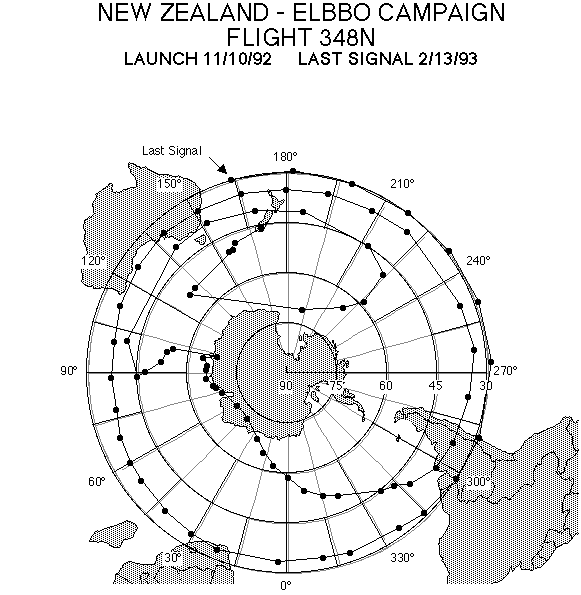Purpose of the flight and payload description
The ELBBO experiment was carried out to investigate electrodynamic and plasma processes including ionospheric convection, global current distribution, middle atmosphere generators and tropospheric sources including thunderstorms.
The balloons were launched from Dunedin, New Zealand and subsequent trajectories took them to latitudes between 29 and 85 degrees south and all longitudes. The payload was composed of instruments to measure the vector electric field, electric conductivity, magnetospheric VLF HISS, VLF subionospheric waves, atmospheric X-rays and environmental temperature and pressure.
The resulting data set of the flights is the largest ever collected (Over 410 payload-days) in a stratospheric, vector electric field balloon-borne experiment, rivaling small satellite programs in the coverage duration.
Details of the balloon flight

Balloon launched on: 11/10/1992 at 17:12 utc
Launch site: Dunedin, New Zealand
Balloon launched by: National Scientific Balloon Facility (NSBF)
Balloon manufacturer/size/composition: Super Pressure Balloon Raven 181.215 cuft (0.92 x 0.92 mil Hoescht 2000 polyester)
Balloon serial number: R.181-1.8SP-109
Flight identification number: 348N
End of flight (L for landing time, W for last contact, otherwise termination time): 2/13/1993
Balloon flight duration (F: time at float only, otherwise total flight time in d:days / h:hours or m:minutes - ): 95 d
Payload weight: 95 lbs
External references
- NASA Balloon Flights (1989-1998) in NASA Historical Data Book, Vol. VII: NASA Launch Systems, Space Transportation, Human Spaceflight, and Space Science, 1989-1998
- Observations and parameterization of the stratospheric electrical conductivity J. Geophys. Res., 101(D23), 29539-29552
- Stratospheric electrodynamics from superpressure balloons - A technical challenge for small payload environments International Balloon Technology Conference, Albuquerque,NM, 1991
5734If you consider this website interesting or useful, you can help me to keep it up and running with a small donation to cover the operational costs. Just the equivalent of the price of a cup of coffee helps a lot.

